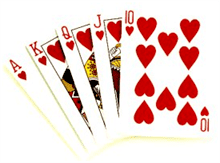In the game of poker, understanding probability is crucial for making informed decisions and increasing your chances of success. Probability refers to the likelihood of a specific event occurring, such as drawing a certain card or forming a winning hand. By calculating probabilities, players can assess the potential outcomes of their actions and make strategic choices accordingly. This article will explore the concept of probability in poker, discussing how to calculate your chances of success and apply this knowledge to improve your gameplay.
Understanding the Basics of Probability in Poker
To begin, let’s define probability in the context of poker. Probability is the likelihood of a specific event occurring. In poker, this can refer to the likelihood of being dealt a certain hand, the likelihood of improving your hand on the flop, or the likelihood of winning the pot.
One of the fundamental concepts in probability is the concept of outs. Outs are the cards that can improve your hand and give you a winning hand. For example, if you have two hearts in your hand and there are two more hearts on the flop, you have nine outs to make a flush. Calculating your outs is the first step in determining your chances of success.
Once you have determined your outs, you can calculate your chances of hitting your hand by using the concept of pot odds. Pot odds compare the size of the current pot to the cost of a contemplated call. By comparing these two numbers, you can determine whether it is mathematically profitable to make the call.
To calculate pot odds, you need to know the size of the current pot and the size of the bet you are facing. Let’s say the pot is $100 and your opponent bets $20. In this case, the pot odds are 5 to 1 (100 divided by 20). This means that for every $1 you invest, you stand to win $5 if you hit your hand.
Now that you know your pot odds, you can compare them to your chances of hitting your hand. This is where the concept of expected value comes into play. Expected value is the average amount of money you can expect to win or lose over the long run.
To calculate your expected value, you multiply your chances of hitting your hand by the amount you stand to win and subtract the chances of not hitting your hand by the amount you stand to lose. If the expected value is positive, it means that making the call is profitable in the long run.
For example, let’s say you have a flush draw with nine outs and the pot odds are 5 to 1. Your chances of hitting your hand are approximately 36% (9 outs out of 47 remaining cards). If the pot is $100, your expected value would be $18 (0.36 multiplied by $100 minus 0.64 multiplied by $20). This means that, on average, you can expect to win $18 every time you make this call.
Understanding the basics of probability in poker is crucial for making informed decisions at the table. By calculating your chances of success using outs, pot odds, and expected value, you can make mathematically sound decisions that will increase your chances of winning in the long run.
How to Calculate Your Odds of Winning in Poker
To calculate your odds of winning in poker, you need to consider two key factors: the number of outs you have and the number of cards remaining in the deck. Outs are the cards that will improve your hand and give you a winning combination. For example, if you have four cards to a flush, there are nine remaining cards of that suit in the deck, so you have nine outs.
Once you have determined your number of outs, you can use the concept of probability to calculate your chances of hitting one of those outs. Probability is a mathematical concept that measures the likelihood of an event occurring. In poker, it helps you determine the likelihood of drawing a specific card from the deck.
To calculate your odds, you can use the concept of “outs and odds.” The formula is simple: divide the number of outs by the number of cards remaining in the deck. For example, if you have nine outs and there are 47 cards left in the deck, your odds of hitting one of your outs on the next card are approximately 19%.
However, poker is a game of multiple betting rounds, so you need to consider the odds of hitting your outs on future cards as well. To calculate your odds of hitting your outs by the river (the fifth and final community card), you can use the concept of “the rule of 4 and 2.” This rule allows you to estimate your chances of hitting your outs after the flop and turn.
To use the rule of 4 and 2, multiply your number of outs by 4 after the flop and by 2 after the turn. For example, if you have nine outs after the flop, your chances of hitting one of your outs by the turn are approximately 36%. This estimation gives you a rough idea of your odds and helps you make informed decisions about whether to continue betting or fold.
It is important to note that calculating your odds in poker is not an exact science. It is an estimation based on the information available at a given moment. As the community cards are revealed and the betting progresses, the number of outs and the number of cards remaining in the deck change, affecting your odds.
Additionally, calculating your odds is just one aspect of poker strategy. It is essential to consider other factors such as your opponents’ playing styles, chip stacks, and position at the table. These factors can influence your decision-making process and should be taken into account alongside your calculated odds.
The Role of Probability in Making Informed Poker Decisions
In poker, probability refers to the likelihood of a certain event occurring. This can range from the probability of being dealt a specific hand to the probability of winning a hand based on the cards on the table. By understanding these probabilities, you can make better decisions about whether to bet, raise, or fold.
One of the most basic concepts in poker probability is the likelihood of being dealt a specific hand. For example, the probability of being dealt a pair of aces is approximately 0.45%. This means that, on average, you can expect to be dealt a pair of aces once every 220 hands. Knowing this probability can help you determine whether it is worth playing a hand or folding.
Calculating the probability of winning a hand is a more complex task. It involves considering not only your own cards but also the cards on the table and the actions of your opponents. This is where the concept of “outs” comes into play. An out is any card that can improve your hand and potentially lead to a winning combination.
To calculate your chances of winning a hand, you need to determine the number of outs you have and then convert that into a percentage. For example, if you have a flush draw with nine outs, you can calculate your chances of hitting your flush by multiplying the number of outs by 2 and adding 1. In this case, your chances of hitting your flush on the next card would be approximately 19%.
Understanding the concept of pot odds is also essential for making informed poker decisions. Pot odds refer to the ratio of the current size of the pot to the cost of a contemplated call. By comparing the pot odds to the odds of completing your hand, you can determine whether it is profitable to continue playing.
For example, if the pot is $100 and your opponent bets $20, you would need to call $20 to stay in the hand. If your chances of completing your hand are 25%, you would need the pot odds to be at least 4:1 to make a profitable call. If the pot odds are higher than 4:1, it would be a good decision to call.
It is important to note that poker is not a game of certainty. Even if the odds are in your favor, there is still a chance that you will lose. However, by understanding and calculating the probabilities, you can make more informed decisions and increase your chances of success in the long run.
Exploring Advanced Probability Concepts in Poker Strategy
To understand probability in poker, it is essential to grasp the concept of odds. Odds represent the ratio of the probability of an event occurring to the probability of it not occurring. In poker, odds are typically expressed as a ratio or a percentage. For example, if the odds of winning a hand are 2 to 1, it means that you are twice as likely to lose as you are to win.
Calculating probabilities in poker involves analyzing the number of possible outcomes and determining the likelihood of each one. This analysis requires an understanding of the different stages of a poker hand, such as pre-flop, flop, turn, and river. Each stage introduces new information that can affect the probabilities.
At the pre-flop stage, players are dealt their hole cards, and the first round of betting takes place. To calculate the probability of getting a specific hand, such as a pair of aces, you need to know the number of possible combinations of that hand and divide it by the total number of possible starting hands. For example, there are four aces in a deck, so the probability of being dealt a pair of aces is 6 out of 1,326 possible starting hands.
As the hand progresses to the flop, three community cards are revealed. This additional information allows players to refine their calculations and adjust their strategies accordingly. For example, if you have a pair of aces, and two more aces are revealed on the flop, the probability of someone else having a better hand decreases significantly.
The turn and river stages further refine the probabilities as more community cards are revealed. Players can calculate the probability of completing specific hands, such as a flush or a straight, by considering the number of outs they have. Outs are the cards that can improve a player’s hand. By dividing the number of outs by the number of unknown cards, players can determine the probability of hitting their desired hand.
Understanding probabilities in poker also involves considering the concept of pot odds. Pot odds compare the current size of the pot to the cost of a contemplated call. By comparing the potential payout to the cost of staying in the hand, players can determine whether it is mathematically profitable to continue playing.
Using Probability to Improve Your Poker Game
Probability is the branch of mathematics that deals with the likelihood of events occurring. In poker, probability is used to determine the likelihood of certain hands being dealt or certain cards being drawn. By understanding the probabilities, you can make better decisions about whether to bet, call, or fold.
To calculate the probability of a particular event occurring, you need to know the number of possible outcomes and the number of favorable outcomes. For example, if you want to know the probability of being dealt a pair in Texas Hold’em, you need to know how many possible pairs there are and how many total starting hands there are. There are 13 different ranks for pairs, and each rank has 6 possible combinations. Therefore, there are 78 possible pairs. Since there are a total of 1,326 possible starting hands, the probability of being dealt a pair is approximately 5.9%.
Understanding the probabilities of different hands being dealt can help you make decisions about whether to play a hand or fold. For example, if you are dealt a pair of aces, you have a strong starting hand with a high probability of winning. On the other hand, if you are dealt a 2 and a 7 of different suits, you have a weak starting hand with a low probability of winning. By considering the probabilities, you can make more informed decisions about whether to invest your chips in a particular hand.
In addition to understanding the probabilities of starting hands, it is also important to consider the probabilities of improving your hand as the community cards are revealed. This is where the concept of “outs” comes into play. An out is a card that will improve your hand and give you a better chance of winning. By counting your outs and calculating the probability of hitting one of them, you can make better decisions about whether to continue betting or fold.
For example, let’s say you have a flush draw after the flop, meaning you have four cards of the same suit and need one more to complete the flush. There are 13 cards of each suit in a standard deck, and you have seen four of them (your two hole cards and the two community cards). This means there are nine remaining cards of your suit that could complete your flush. With 47 unknown cards, the probability of hitting your flush on the next card is approximately 19%. By comparing the probability of hitting your flush to the size of the pot and the cost of the bet, you can make an informed decision about whether to continue betting or fold.
In conclusion, probability is a crucial tool in poker strategy. By understanding the probabilities of different starting hands and the likelihood of improving your hand as the community cards are revealed, you can make more informed decisions and increase your chances of success. While luck may still play a role in the short term, it is the skillful use of probability that will ultimately determine your long-term profitability in poker. So, take the time to study and calculate the probabilities, and watch your game improve.




